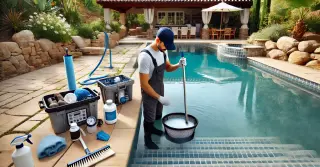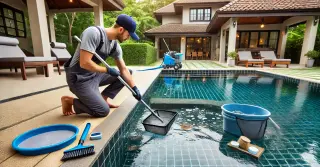Pool Chemical Balance

Maintaining the proper chemical balance is crucial for a safe and healthy swimming environment. Proper chemical levels prevent the growth of algae and bacteria, keep the water clear and clean, and protect the pool's surface and equipment.
- Maintaining Proper pH: Your pool's pH level reflects its acidity or alkalinity. The ideal pH range is between 7.2 and 7.6. Low pH levels result in acidic water, causing skin irritation and equipment corrosion. Alkaline water from high pH causes cloudiness and scaling. Frequent pH testing and adjustments is crucial for comfort and safety.
- Managing Chlorine Concentration: Chlorine is essential for pool hygiene, killing bacteria, algae, and other harmful microorganisms. The ideal chlorine level should be between 1-3 ppm (parts per million). Low chlorine levels cause unsanitary water, with bacteria and algae proliferating. Too much chlorine can cause skin and eye irritation and produce a strong chlorine odor. Consistently monitoring and adjusting chlorine levels ensures sanitation and comfort.
Optimal Alkalinity LevelsTotal alkalinity is a crucial element of pool chemistry. Alkalinity buffers pH levels, helping to prevent drastic changes in pH. The optimal total alkalinity range is 80-120 ppm.
- Avoiding pH Fluctuations: Balanced alkalinity stabilizes pH levels, preventing rapid pH changes that irritate skin and damage surfaces. Low alkalinity results in unstable pH levels, making consistent balance difficult. High alkalinity causes cloudy water and scaling. Frequent alkalinity testing and adjustments is essential for maintaining a stable and balanced pool.
- Managing Calcium Hardness: Calcium hardness indicates the calcium level in pool water. Optimal calcium hardness levels are between 200-400 ppm. Insufficient calcium causes corrosive water, damaging surfaces and equipment. If calcium levels are too high, it can cause scaling on pool surfaces and cloud the water. Regularly testing and adjusting calcium hardness is crucial for safeguarding your pool and maintaining clear water.
Using Pool Chemicals SafelyHandling and storing pool chemicals properly is essential for both safety and effectiveness. Store chemicals in a cool, dry place, away from sunlight, children, and pets. Always follow the manufacturer's instructions for proper dosing and application.
- Proper Chemical Measurement and Mixing: Measuring pool chemicals accurately is vital for correct balance. Inaccurate dosing can disrupt the chemical balance and affect water quality. Always use a clean, dry measuring cup or scoop and avoid mixing chemicals directly. Mix chemicals in water if required, following the instructions carefully.
- Chemical Reaction Awareness: Certain chemicals can react dangerously if mixed. For instance, never mix chlorine and acid. Being aware of these interactions avoids accidents and ensures safe use. Keep chemicals separate and handle with caution to prevent harmful reactions.
Ensuring the right chemical balance in your pool is vital for a safe, clean, and pleasant swimming experience. By consistently testing and adjusting pH, chlorine, alkalinity, and calcium, you maintain optimal water conditions.
Proper chemical use and storage improve the safety and longevity of your pool.




